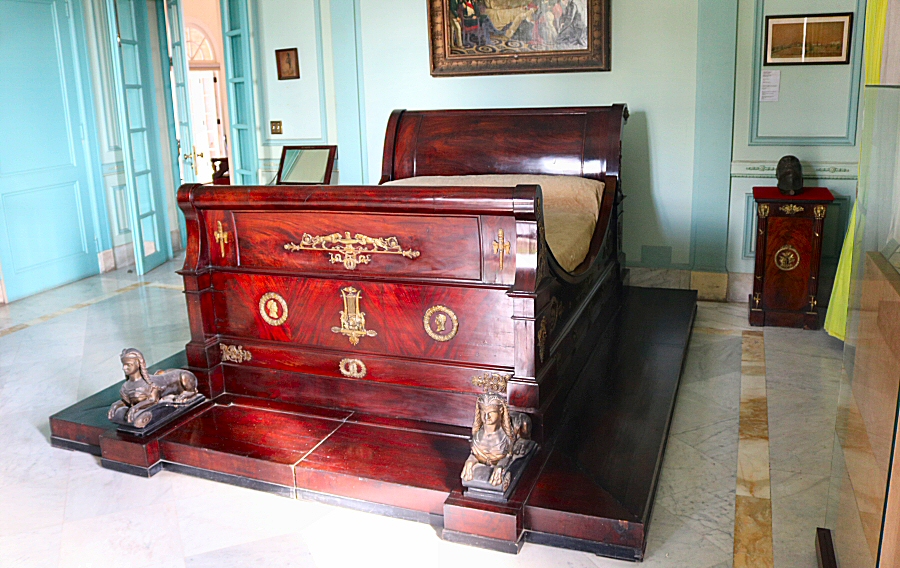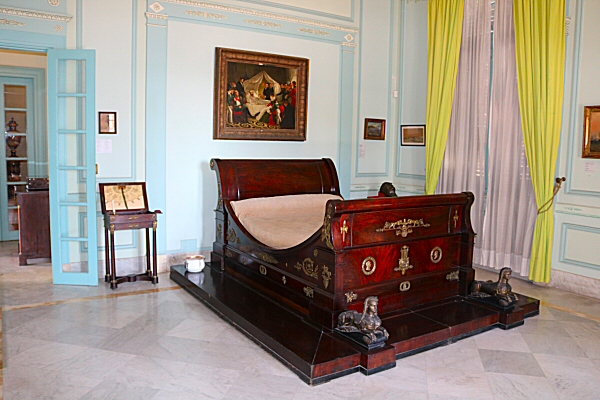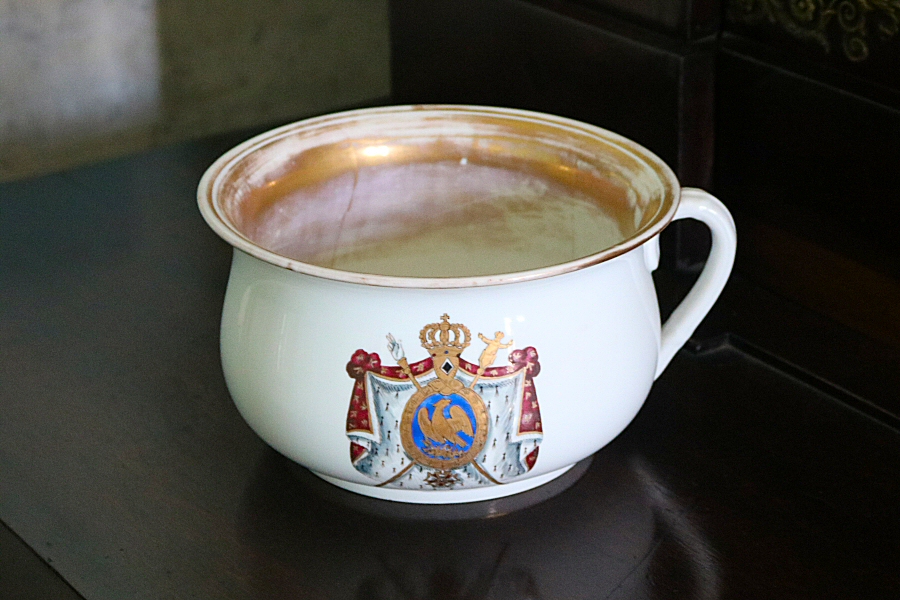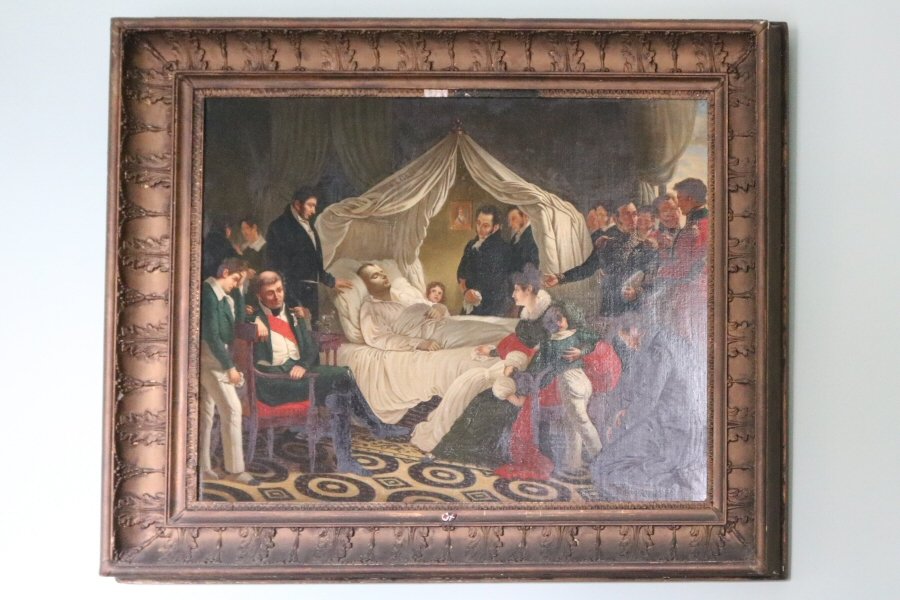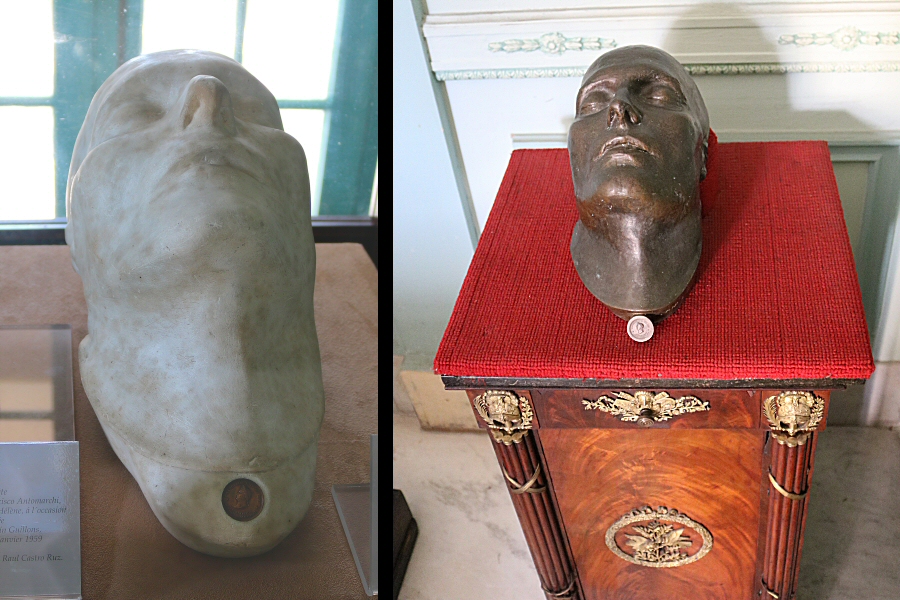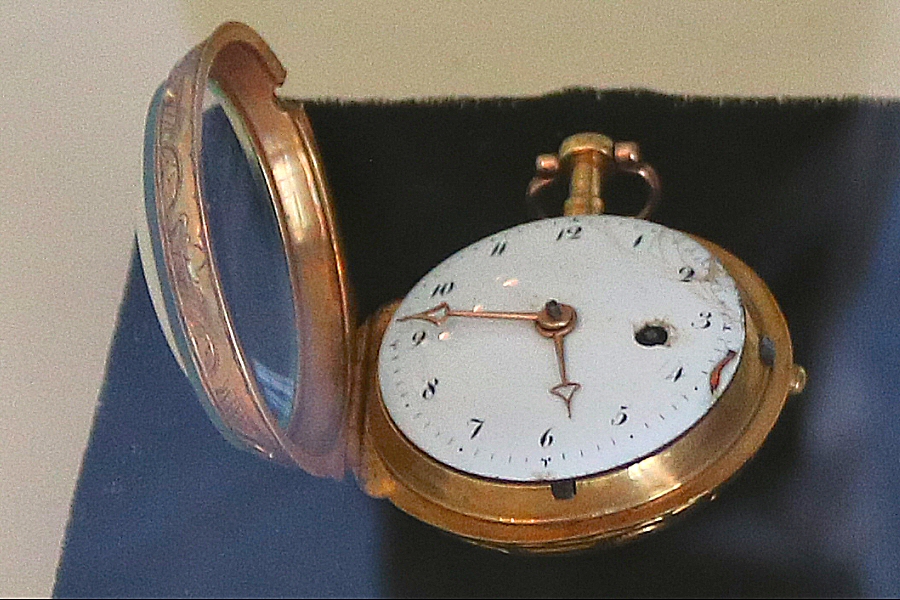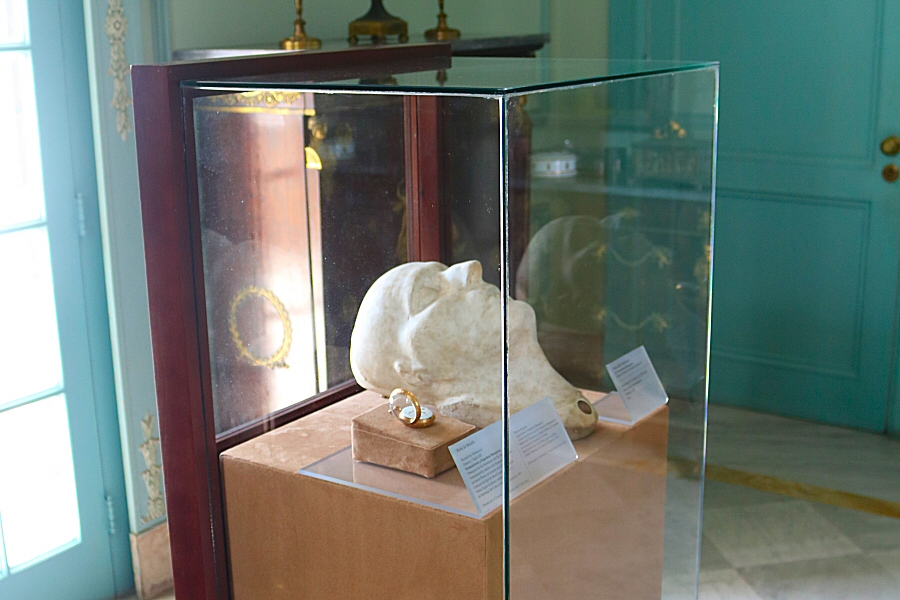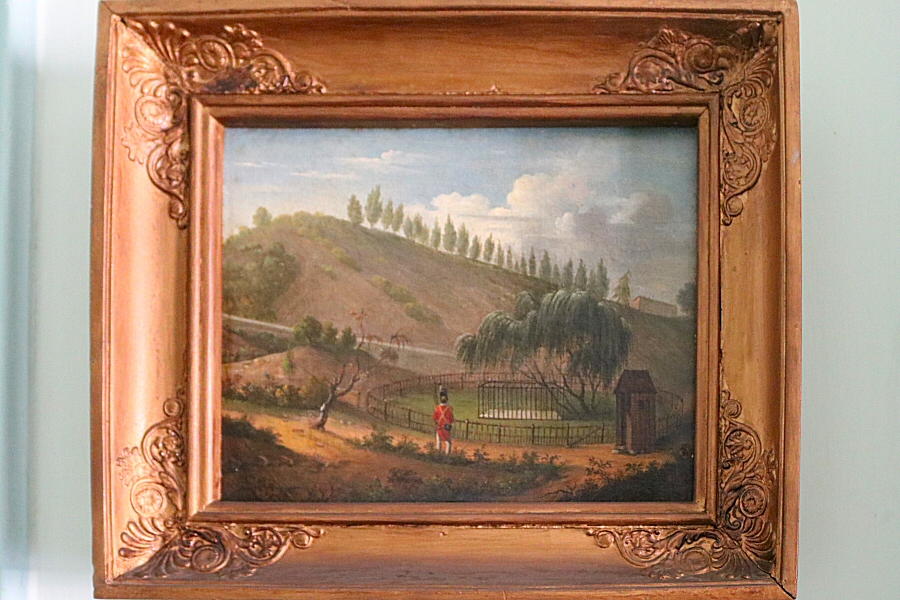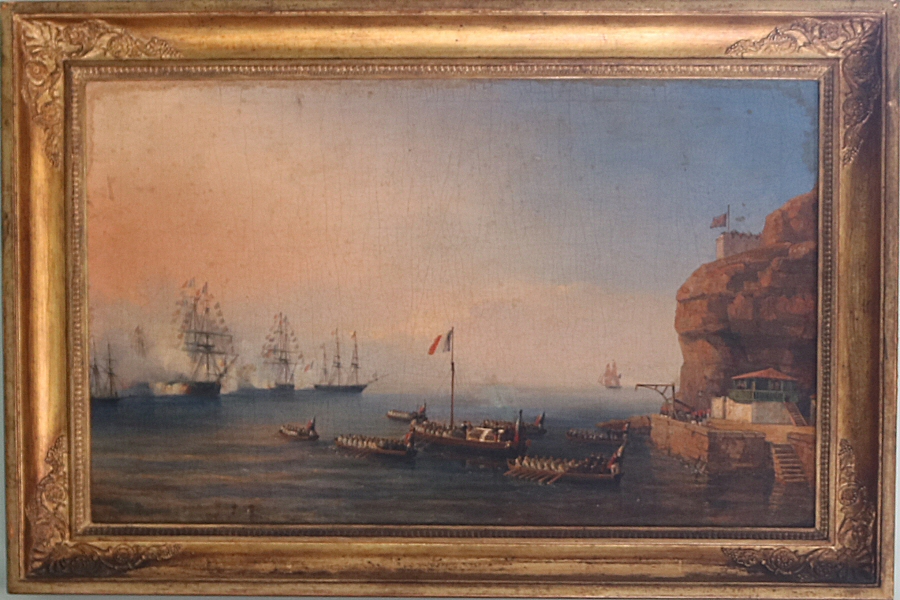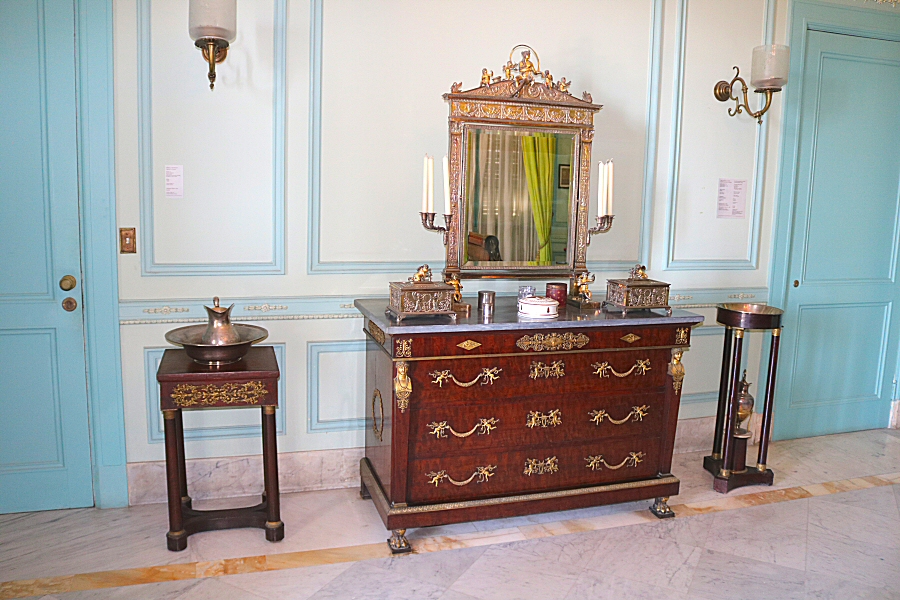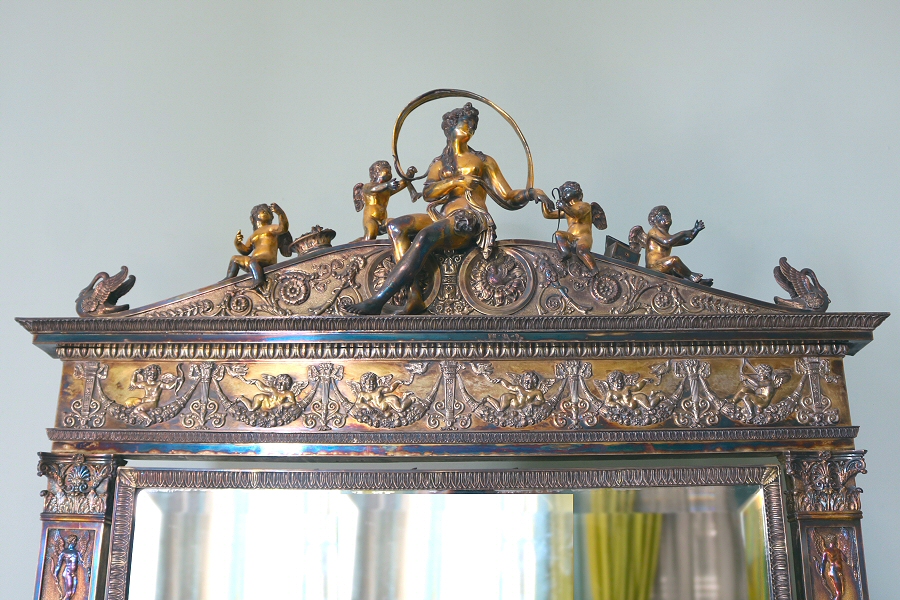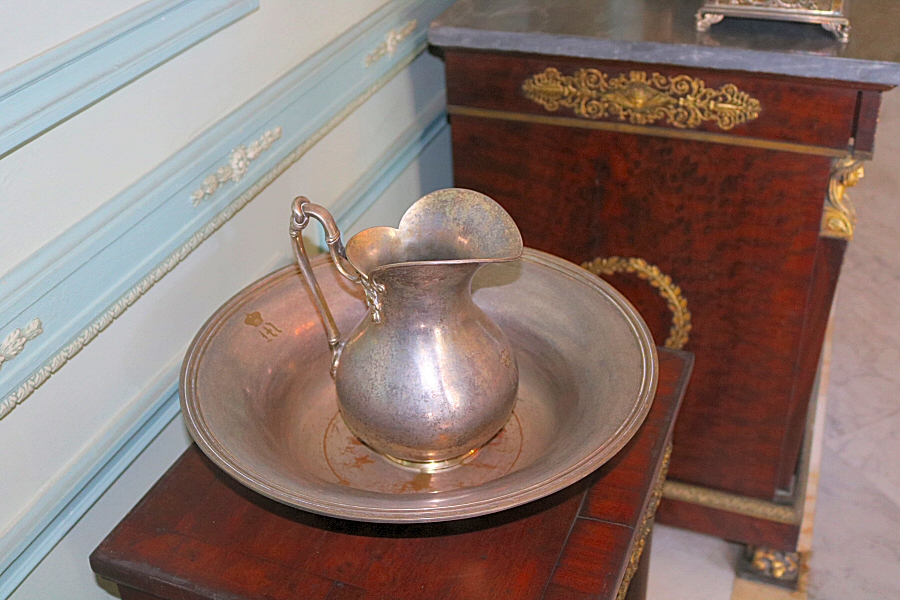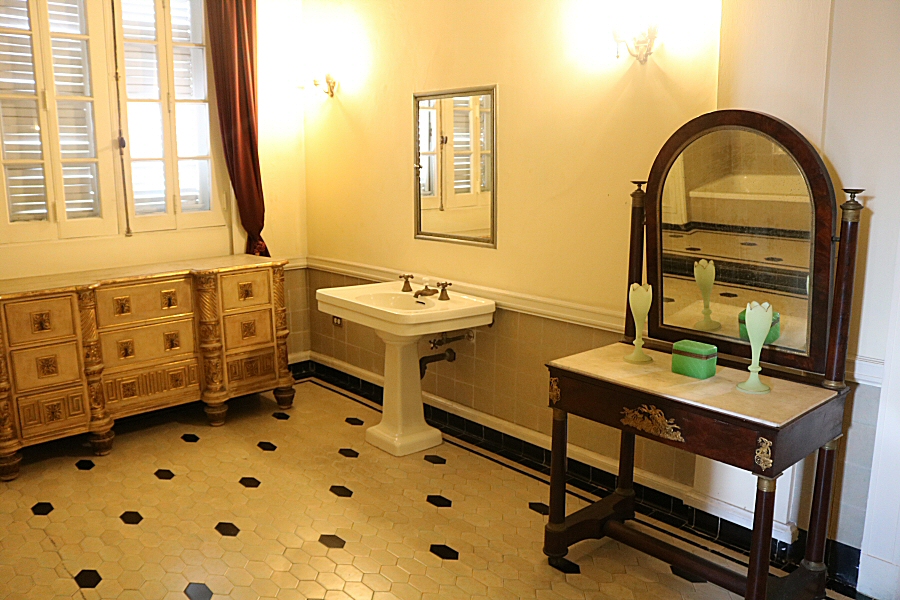
The gondola-type bed is made of mahogany and
has nice bronze ornaments. It was manufactured in France. The
pink French coverlet that was spread over the bed, was used by
Napoléon during his stay on St. Helena island. A porcelain
chamber pot that has the coat of arms of the First Empire
depicted on it and a dressing table with a mirror stands next to
the bedstead. The latter is made of oak, veneered in mahogany.
The bedroom contains several valuable pieces
associated with Napoléon Bonaparte. The oil painting, hung on
the wall of the bedside, depicts the death of Napoléon Bonaparte
in camp bed at Longwood House on St. Helena island in 1821. The
original is the work of Charles Steuben; the painting in the
museum is one of the many copies made by other artists. In the
painting we see that Napoléon’s whole entourage gathered around
him during his last hours, but his family is missing, neither
his wife Marie Louise, nor his brothers and sisters whom he had
raised to royalty. The man that stands on the left with his hand
on Napoléon’s pillow is the Corsican doctor Francesco
Antommarchi (François Carlo Antommarchi) that made the autopsy
of the Emperor after his death and made the mold of his face.
The woman sitting on the right chair is the Countess
Françoise-Elisabeth Bertrand (Fanny Dillon), the wife of Count
Henri-Gatien Bertrand that sits on the left chair. The three
children in the painting are their children, Napoléon, Hortense
and Henry respectively.
In fact, the painting is a
collective work. To represent the death scene as accurate as
possible, Steuben portrayed the companions of
Napoléon later when they returned to
France, but he painted only Abbé
Vignali, William
Crokat and the doctor
Arnott from memory. The Grand
Maréchal Bertrand made a sketch of the
room, marking the position of the furniture and the people
around Napoléon. Later, Charles
Steuben brought all these together
On the left side of the bedstead, there is
the death mask of the Emperor. Before the invention of the
photography, it was a custom that goes back to several
centuries, to make a cast mold of the face of the ruler, king or
emperor. The plaster mold was created by Dr. Francesco
Antommarchi two days after the death of Napoléon. There are only
hundred authenticated death masks of Napoléon Bonaparte, copied
from the original plaster mold. These death masks, made of metal
or plastic, appear in several museums all over the world. There
are two masks in the museum’s collection: the bronze version and
the plaster version. The mask that you see on the night table is
the bronze mask, made by Michard and Quesnel. The plaster
version was brought to Cuba by Dr. Francesco Antommarchi himself
that settled in Santiago de Cuba in 1838 where he lived at his
cousin’s coffee plantation. To get on with the authorities,
Antommarchi presented the mask to General Juan de Moya, the
Governor of Santiago de Cuba, that was a great admirer of
Napoléon. When Antommarchi died of yellow fever in this province
in 1938, the mask was purchased by José Lacret Morlot, General
of the Liberation Army. When the general died, his heirs put the
mask on sale by publishing an advertisement in New York Times in
1916. Probably, Julio Lobo Olavarría took its possession by this
way. Both of the masks are on the display.
Even though, the procedure is quiet well
reported in Napoléon’s valet memoir, some argue that Dr.
Antommarchi’s attempt to mold the face of Napoléon failed, so
that the original plaster mask belonged to the British doctor
Francis Burton, but the Countess Françoise-Elisabeth Bertrand
stole it and gave it to Dr. Antommarchi.
The night table on which the mask stands,
has a military-style. It was made by the French firm Jacob-Desmalters
and the bronze work belongs to Pierre Philippe Thomire.
Another valuable piece of the collection is
the golden pocket watch of Napoléon that he wore on the St.
Helena island. Napoléon Bonaparte had two pocket watches on the
St. Helena island, one large silver watch (Frederick the Great’s
alarm clock) and one golden watch. However, only the silver one
was mentioned in the official wish of Napoléon. It is still
unknown, how the golden pocket watch that we see in this museum,
could pass into the hands of Dr. Francesco Antommarchi. After
the death of Napoléon, Dr. Antommarchi went to Cuba in 1837 and
settled in Santiago de Cuba, as he had wealthy relatives there.
It is not known, how the pocket watch changed hands and became
the possession of the Guillois’ family, a well-known French
family that had a long past in Santiago de Cuba, but Vilma Espin
Guillois acquired it as wedding gift from her family, when he
married Raúl Castro in Santiago de Cuba in 1959. When Vilma
Espin Guillois died in 2007, Raúl Castro donated the pocket
watch to the Museo Napoleónico de la Habana on the occasion of
its reopening in 2011. The manufacturer of the watch is Jacques
Boussot de Villeneuve from Paris. The golden pocket watch,
manufactured in the 18th century, has an enamel clock face and a
crystal watch glass. It is stopped at a few minutes to six, the
approximate time of death of Napoléon Bonaparte. It should have
an emotional significance to Napoléon, as he wore it until his
death.
On the wall above the bronze mask, there are
two paintings. One of them is the watercolor painting of
Longwood House that served as Napoléon’s residence on the island
of St. Helena from 1815 until to his death in 1821. It is the
work of Jean Baptiste Vignault. In fact, Longwood House was his
prison in the middle of South Atlantic.
Other painting is an oil painting with the
title “View of the Tomb of Napoléon on St. Helena", presents a
view of the Valley of the Geranium where the tomb of the emperor
was. Napoléon wished to be buried on the banks of the river
Seine, but the British government did not transport his corpse
to France and he was buried in a tin coffin, placed in another
coffin, made of mahogany, into a pit of three meters deep and
sealed with thick cement.
There is also another oil painting in the
bedroom, and it represents the transfer of the sarcophagus of
Napoléon to the French frigate “La Belle Poule” that would bring
the corpse of the emperor to France. It is the work of Sebastian
Mayer and has the title “Return of Napoléon to France”.
The bedroom contains a gilded silver set,
manufactured by the prestigious silversmith Jean_Baptiste Claude
Odiot in 1822: the mirror, the jewelry caskets and the water jug
with the basin. In fact, Tsar Alexander II ordered the set
during his visit to Paris in 1821, devising it as a gift for his
mistress Maria Antonova Naryshkin. Even though, it is known as
the work of Jean Baptiste Claude Odiot, the efforts contributed
by some finest artists of the time should not be missed. The
nude female figure atop the cornice of the mirror was designed
by Pierre-Philippe Thomire and the design of the caskets belong
to the painter Pierre-Paul Prud’hon and the artisan Adrien-Louis-Marie
Cavelier. The set was manufactured as a wedding gift on the
occasion of the marriage of Napoléon with his second wife, Marie
Louise, in 1810. It was intended for the bedroom in Chateau de
Fontainebleau. So-called Marie-Louisa set was ornamented with
lapis-lazuli stones and mother of pearls. However, the set was
melted in Parma in 1836.
The mirror is framed by silver plate,
ornamented with different figures. The mirror is topped by a
seated nude female figure, representing Venus, and two putti on
each side of it. The putti hold a loop above Venus’ head. The
swivel mirror has three candle holders on each side. Similarly,
two identical jewel caskets have a cherub atop, watering a
plant. The caskets have spread-winged doves sitting on a laurel
wreath and Corinthian pillars at the corners. On either side of
the caskets two putti are holding a laurel victory wreath. The
handle to lift the casket’s cover has another putto, represented
as harvesting fruit. The putto figures, as well as their relief
s on the jewelry caskets were designed by the painter Pierre
Paul Prud’hon and realized by the artisan Adrien-Louis-Marie
Cavelier. The jewelry caskets were originally made of vermeil,
but much of the gold has worn off over the years.
The secretary and the dresser, as well as
the sterling silver water jug and the bowl on the dresser
belonged to the Princess Mathilde Bonapart, the daughter of
Napoléon's brother Jérôme Bonaparte and his second wife,
Catherine of Württemberg. The hand-cut crystal tumbler with its
own travel case embossed in golden bee belonged to Josephine de
Beauharnais. The cameo of the emperor on the crystal glass is
the work of the French sculptor Bertrand Andrieu.
